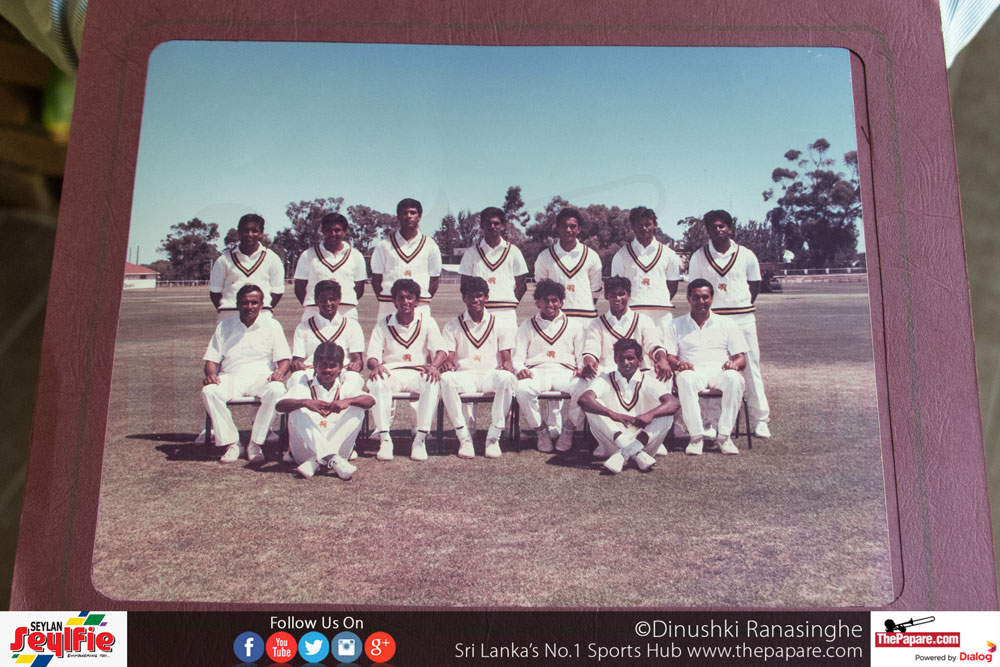In 1988, I had the privilege of managing the Sri Lankan Under 19 Team to the above tournament in Australia, with Mr. Anuruddha Polonowita as my assistant.
Our first task was to select 14 players to represent the country. We requested all cricket playing schools to nominate three players, for us to ascertain their suitability and we received around 230 nominations. Mr.Polonowita and I watched these boys bat and bowl at the nets and we pruned the numbers to 44 players. Two trial games were played amongst the 44 players after which, 22 were selected for another trial game. The game between these 22 players enabled us to pick the final squad of 14 players. This entire process took us two months from December 1987 to January 1988. In February, the boys underwent physical fitness training and skills training in batting, bowling and fielding.
The touring squad emplaned on 22nd February and after transiting in Singapore overnight, reached Melbourne in the early hours of 24th morning. This tournament was played in the townships of the Riverland Area which is situated along the Murray river in South Australia. This area is orchard and farm country known worldwide for its production of quality wines, juices and dried fruits. The Eight teams, representing the Test playing countries and the ICC Associate Team were assigned each to one of these towns and two players of each team were hosted by a family, while the Managers and the Assistant Managers were accommodated in Motels. The team was flown from Melbourne to Mildura from where we had to take a coach ride of two and a half hours to our host town of Barmera. During the coach journey, we saw some dogs which were enormous by Sri Lankan standards and there were comments in sinhala by some of the boys that Australian dogs resembled horses.
Bamera’s population was approximately 5000 with the majority of teenagers away in the colleges of the big cities pursuing their secondary education. We were welcomed by the Mayor and the hosting families at the city centre. After a reception I had the task of assigning two players per family. This selection had to be done carefully as it was necessary to pair off boys who were fluent in English with ones who were less fluent to avoid communication problems between the hosts and the boys. Whilst the hosting arrangement gave the boys an insight to Australian culture and hospitality, it was not very conducive for team management and briefings. An incident which broke me into a cold sweat was when one of the boys contacted a touch of bronchitis and revealed to me later, that they had gone out boating with the host family in the evening on Lake Bonney and the chilly winds had been the cause of it. The host family had good intentions of giving the two boys a boating experience which was a normal, pleasurable activity for them.
On the 25th we had a centre wicket practice session from 4-7 p.m. at the Barmera Club grounds, which was not sufficient for us to adapt ourselves for what was to follow. A 50 overs practice game against the English Team was played on the following day when the temperature was around 42 degrees celcius during the course of play. Due to this scorching dry heat, a few boys collapsed while fielding and had to be rehydrated with special beverages. Sri Lanka’s first game was against New Zealand played at Berri. New Zealand was put into bat first and scored 178 runs for 9 wickets in their 50 overs. Sanath Jayasuriya (3 for 34), Rohan Weerakkody (2 for 24) and Johanne Samarasekera (2 for 20) were among the wickets. Sri Lanka in reply were out for 166 in 47.4 overs. The main contributors were Chaminda Mendis (43) and Sanjeeva Ranatunge (32). Romesh Kaluwitharana, when batting well, was run out at 19 which enabled New Zealand to win this game by 12 runs. Sri Lanka also dropped a few high catches mainly due to fielders being unable to pick up the flight of the ball in the cloudless sky, which factor plagued us for the early games in this tournament.
Sri Lanka’s second match against Pakistan in our host town Barmera saw Pakistan winning the toss and electing to bowl first. Sri Lanka were 151 all out in 48.3 overs. Chaminda Mendis was outstanding in scoring 74 runs. There were 4 run outs in this innings which halted Sri Lanka’s progress. Pakistan in their reply made 152 for 3 in 39 overs. Captain Rohan Weerakkody though not capturing any wickets bowled economically to concede only 24 runs in his 10 overs.
Our third game was against Australia at Merbein, where Australia won the toss and batted first to post a total of 249 in 48 overs. Dilhan Perera (3 for 36) and Chaminda Mendis (4 for 35) bowled exceptionally well to restrict the Australian score on a featherbed batting wicket. Sri Lanka in reply were bowled out for 225 in 47 overs conceding a 24 run victory to the Aussies. Chaminda Mendis (63), Ajith Alirajah (37) and Chandika Hathurusinghe (53) contributed to the total. After having got a start of 101 runs by the openers, Sri Lanka squandered this effort by conceding 4 run outs.
The fourth game against England was at Barmera, where England won the toss and elected to bat. We did well to restrict them to a score of 102 in 41 overs with Hathurusinghe (3 for 36) and Chaminda Fernando (3 for 29) doing the damage. Sri Lanka made heavy weather of over hauling this score in 36 overs for the loss of 6 wickets with Ajith Alirajah being the main contributor in scoring 32 runs. The low scores were mainly due to the wicket having unpredictable bounce, which is reflected by the scores in this match.
The fifth game against the West Indies at Barmera saw West Indies take first strike after winning the toss and scoring 201 for 8 in 50 overs. K.G. Priyantha (3 for 32) and Dilhan Perera (3 for 30) were the successful bowlers. Brian Lara who captained the West Indies made a score of 38 and showed signs of being a champion batsman in the future. Sri Lanka were bowled out for 101 in 39 overs in their innings with Chaminda Mendis showing good resistance in scoring 28 runs, with the unpredictable bounce causing the debacle once again.
Sri Lanka took on the ICC Associates Team at Mildura and in having won the toss elected to bat and totaled 231 for 7 in 50 overs. Sanjeeva Ranatunge (61) and Ajith Alirajah (54) were the main scorers. The ICC Associates Team in their turn did well to score 184 for 7 in their 50 overs. The margin of victory for Sri Lanka was 47 runs. Chaminda Fernando (3 for 29) and Sanath Jayasuriya (2 for 23) were among the wickets.
The final game of the preliminary round was against India at Berri. India won the toss and opted to bowl first. Sri Lanka was able to total 190 for 9 in 50 overs with Sanath Jayasuriya making 53, Johanne Samarasekera 42 and Chaminda Fernando 30. The Indians in their innings were bowled out for 140 in 28 overs with all the bowlers bowling exceptionally well and sharing the wickets. Although we ended the preliminary round on a winning note, we were unable to be amongst the first four teams and subsequently missed out on the Semi-Finals. Had our running between the wickets and our catching been better, we certainly would have qualified for a semi final berth as we lost the games against Australia and New Zealand by very narrow margins. The Final Round was played in Adelaide and our team too was given the opportunity to travel there to watch the games and have the privilege of meeting the great Sir Don Bradman who was the Guest of Honor at the Final.
It must be stated that at least 3 players from most of the participating teams, went on to represent their respective countries with distinction at International level. Although the first Under 19 world cup did not have the facilities that are now enjoyed by Youth World Cup Teams, this was a good start to encourage aspiring young cricketers to play International Cricket.














